Abstract
Five to ten percent of individuals with melanoma have another affected family member, suggesting familial predisposition. Germ-line mutations in the cyclin-dependent kinase (CDK) inhibitor p16 have been reported in a subset of melanoma pedigrees, but their prevalence is unknown in more common cases of familial melanoma that do not involve large families with multiple affected members. We screened for germ-line mutations in p16 and in two other candidate melanoma genes, p19ARF and CDK4, in 33 consecutive patients treated for melanoma; these patients had at least one affected first or second degree relative (28 independent families). Five independent, definitive p16 mutations were detected (18%, 95% confidence interval: 6%, 37%), including one nonsense, one disease-associated missense, and three small deletions. No mutations were detected in CDK4. Disease-associated mutations in p19ARF, whose transcript is derived in part from an alternative codon reading frame of p16, were only detected in patients who also had mutations inactivating p16. We conclude that germ-line p16 mutations are present in a significant fraction of individuals who have melanoma and a positive family history.
Full text
PDF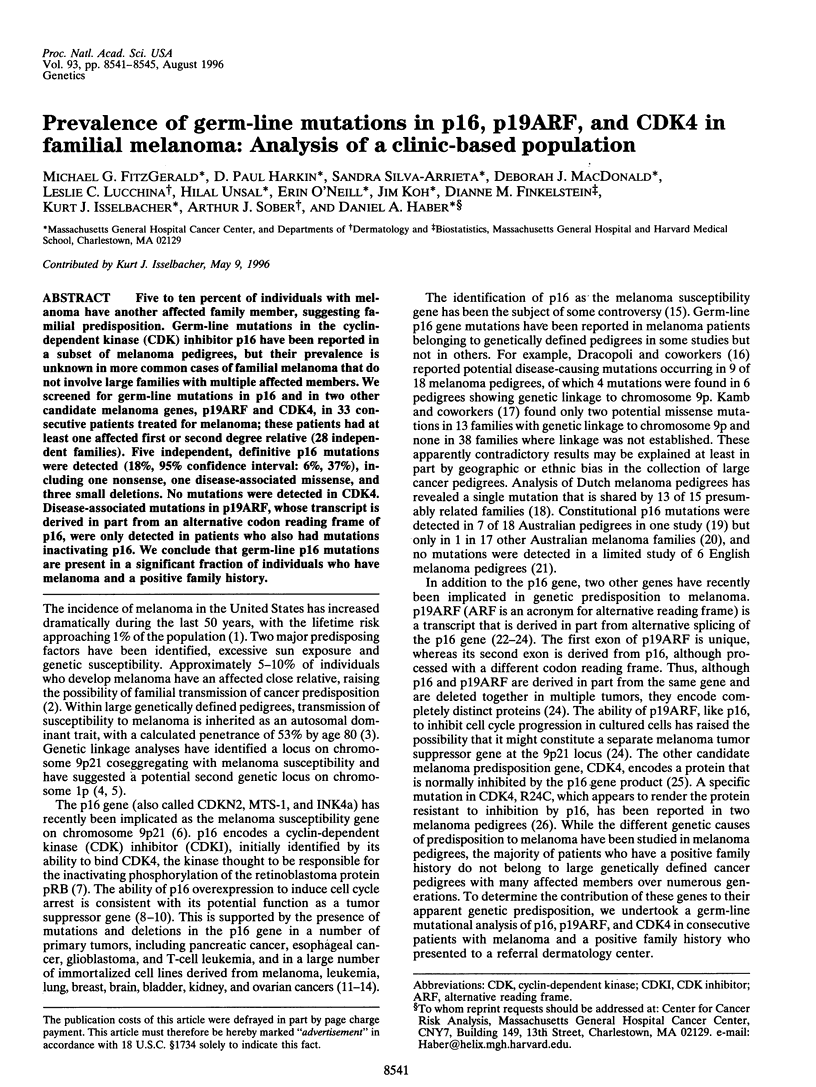
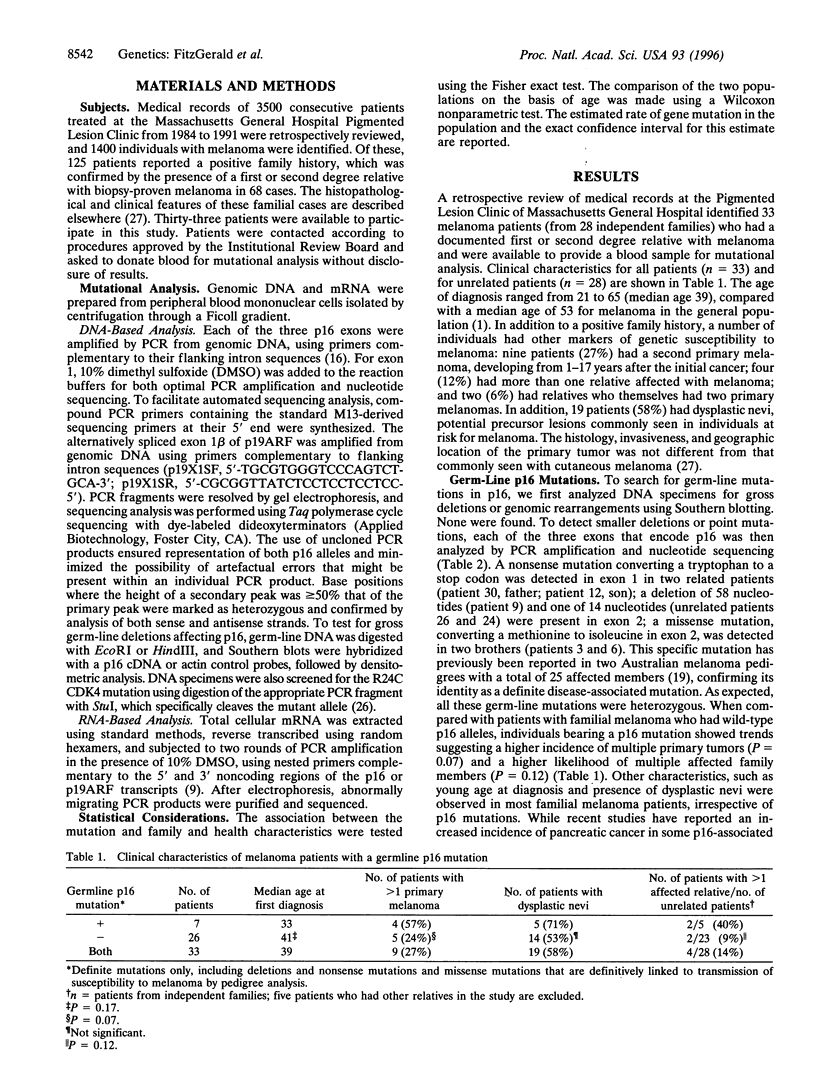
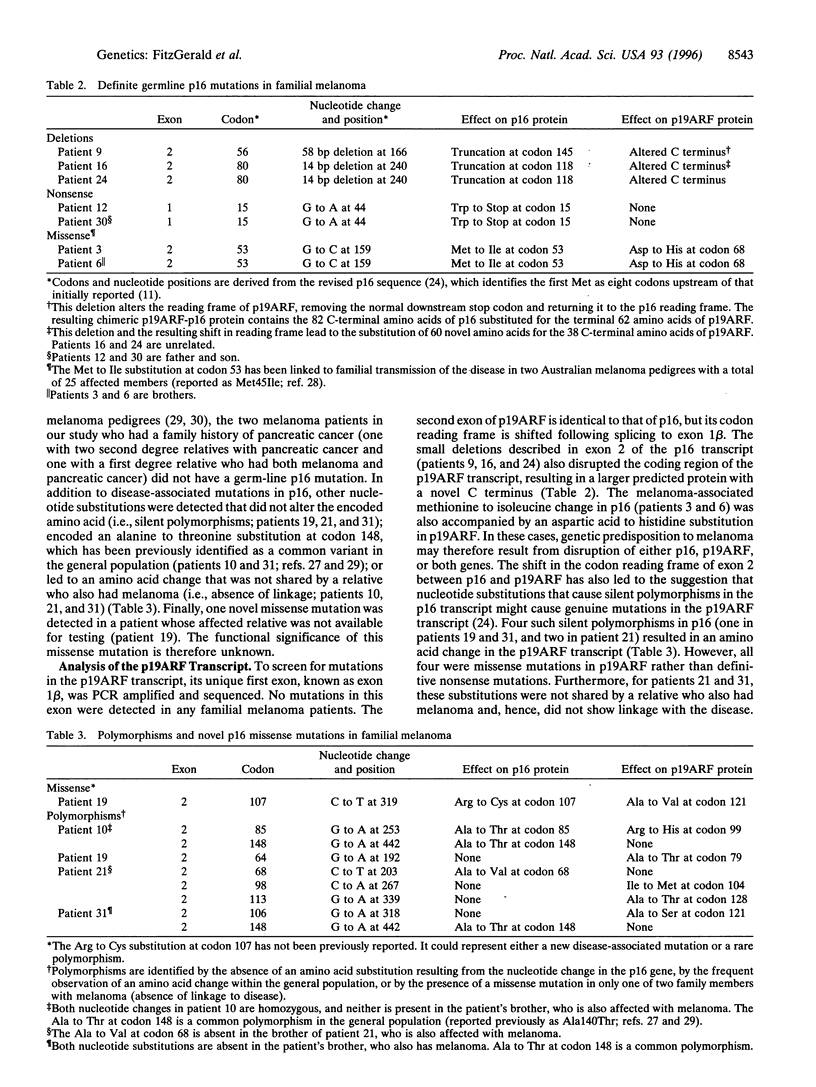
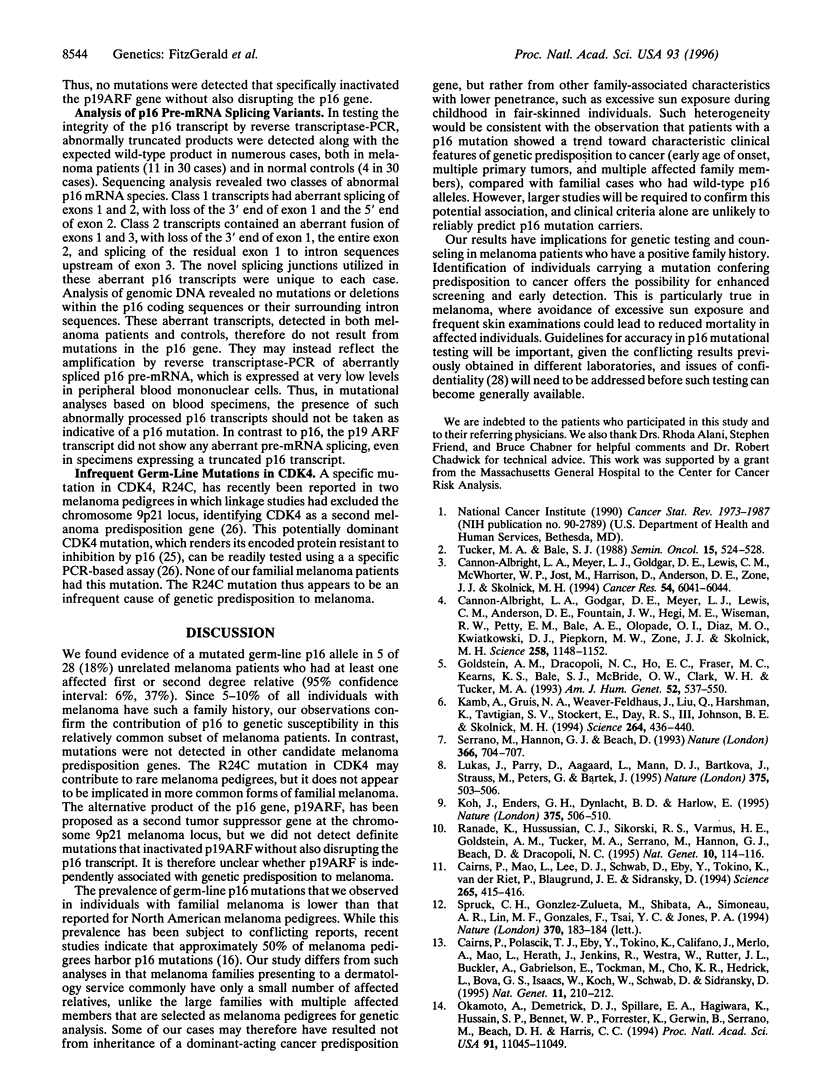
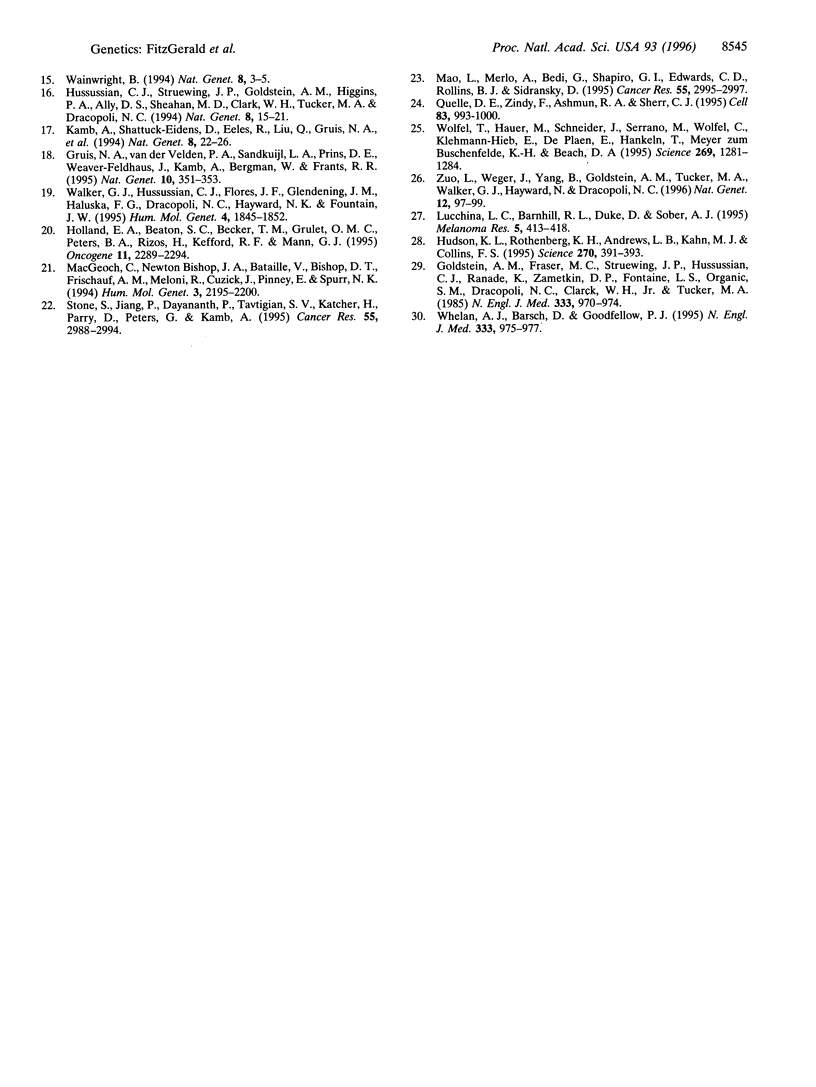
Selected References
These references are in PubMed. This may not be the complete list of references from this article.
- Cairns P., Mao L., Merlo A., Lee D. J., Schwab D., Eby Y., Tokino K., van der Riet P., Blaugrund J. E., Sidransky D. Rates of p16 (MTS1) mutations in primary tumors with 9p loss. Science. 1994 Jul 15;265(5170):415–417. doi: 10.1126/science.8023167. [DOI] [PubMed] [Google Scholar]
- Cairns P., Polascik T. J., Eby Y., Tokino K., Califano J., Merlo A., Mao L., Herath J., Jenkins R., Westra W. Frequency of homozygous deletion at p16/CDKN2 in primary human tumours. Nat Genet. 1995 Oct;11(2):210–212. doi: 10.1038/ng1095-210. [DOI] [PubMed] [Google Scholar]
- Cannon-Albright L. A., Meyer L. J., Goldgar D. E., Lewis C. M., McWhorter W. P., Jost M., Harrison D., Anderson D. E., Zone J. J., Skolnick M. H. Penetrance and expressivity of the chromosome 9p melanoma susceptibility locus (MLM). Cancer Res. 1994 Dec 1;54(23):6041–6044. [PubMed] [Google Scholar]
- Goldstein A. M., Dracopoli N. C., Ho E. C., Fraser M. C., Kearns K. S., Bale S. J., McBride O. W., Clark W. H., Jr, Tucker M. A. Further evidence for a locus for cutaneous malignant melanoma-dysplastic nevus (CMM/DN) on chromosome 1p, and evidence for genetic heterogeneity. Am J Hum Genet. 1993 Mar;52(3):537–550. [PMC free article] [PubMed] [Google Scholar]
- Goldstein A. M., Fraser M. C., Struewing J. P., Hussussian C. J., Ranade K., Zametkin D. P., Fontaine L. S., Organic S. M., Dracopoli N. C., Clark W. H., Jr Increased risk of pancreatic cancer in melanoma-prone kindreds with p16INK4 mutations. N Engl J Med. 1995 Oct 12;333(15):970–974. doi: 10.1056/NEJM199510123331504. [DOI] [PubMed] [Google Scholar]
- Gruis N. A., van der Velden P. A., Sandkuijl L. A., Prins D. E., Weaver-Feldhaus J., Kamb A., Bergman W., Frants R. R. Homozygotes for CDKN2 (p16) germline mutation in Dutch familial melanoma kindreds. Nat Genet. 1995 Jul;10(3):351–353. doi: 10.1038/ng0795-351. [DOI] [PubMed] [Google Scholar]
- Holland E. A., Beaton S. C., Becker T. M., Grulet O. M., Peters B. A., Rizos H., Kefford R. F., Mann G. J. Analysis of the p16 gene, CDKN2, in 17 Australian melanoma kindreds. Oncogene. 1995 Dec 7;11(11):2289–2294. [PubMed] [Google Scholar]
- Hudson K. L., Rothenberg K. H., Andrews L. B., Kahn M. J., Collins F. S. Genetic discrimination and health insurance: an urgent need for reform. Science. 1995 Oct 20;270(5235):391–393. doi: 10.1126/science.270.5235.391. [DOI] [PubMed] [Google Scholar]
- Hussussian C. J., Struewing J. P., Goldstein A. M., Higgins P. A., Ally D. S., Sheahan M. D., Clark W. H., Jr, Tucker M. A., Dracopoli N. C. Germline p16 mutations in familial melanoma. Nat Genet. 1994 Sep;8(1):15–21. doi: 10.1038/ng0994-15. [DOI] [PubMed] [Google Scholar]
- Kamb A., Gruis N. A., Weaver-Feldhaus J., Liu Q., Harshman K., Tavtigian S. V., Stockert E., Day R. S., 3rd, Johnson B. E., Skolnick M. H. A cell cycle regulator potentially involved in genesis of many tumor types. Science. 1994 Apr 15;264(5157):436–440. doi: 10.1126/science.8153634. [DOI] [PubMed] [Google Scholar]
- Kamb A., Shattuck-Eidens D., Eeles R., Liu Q., Gruis N. A., Ding W., Hussey C., Tran T., Miki Y., Weaver-Feldhaus J. Analysis of the p16 gene (CDKN2) as a candidate for the chromosome 9p melanoma susceptibility locus. Nat Genet. 1994 Sep;8(1):23–26. doi: 10.1038/ng0994-22. [DOI] [PubMed] [Google Scholar]
- Koh J., Enders G. H., Dynlacht B. D., Harlow E. Tumour-derived p16 alleles encoding proteins defective in cell-cycle inhibition. Nature. 1995 Jun 8;375(6531):506–510. doi: 10.1038/375506a0. [DOI] [PubMed] [Google Scholar]
- Lucchina L. C., Barnhill R. L., Duke D. M., Sober A. J. Familial cutaneous melanoma. Melanoma Res. 1995 Dec;5(6):413–418. doi: 10.1097/00008390-199512000-00004. [DOI] [PubMed] [Google Scholar]
- Lukas J., Parry D., Aagaard L., Mann D. J., Bartkova J., Strauss M., Peters G., Bartek J. Retinoblastoma-protein-dependent cell-cycle inhibition by the tumour suppressor p16. Nature. 1995 Jun 8;375(6531):503–506. doi: 10.1038/375503a0. [DOI] [PubMed] [Google Scholar]
- MacGeoch C., Bishop J. A., Bataille V., Bishop D. T., Frischauf A. M., Meloni R., Cuzick J., Pinney E., Spurr N. K. Genetic heterogeneity in familial malignant melanoma. Hum Mol Genet. 1994 Dec;3(12):2195–2200. doi: 10.1093/hmg/3.12.2195. [DOI] [PubMed] [Google Scholar]
- Mao L., Merlo A., Bedi G., Shapiro G. I., Edwards C. D., Rollins B. J., Sidransky D. A novel p16INK4A transcript. Cancer Res. 1995 Jul 15;55(14):2995–2997. [PubMed] [Google Scholar]
- Okamoto A., Demetrick D. J., Spillare E. A., Hagiwara K., Hussain S. P., Bennett W. P., Forrester K., Gerwin B., Serrano M., Beach D. H. Mutations and altered expression of p16INK4 in human cancer. Proc Natl Acad Sci U S A. 1994 Nov 8;91(23):11045–11049. doi: 10.1073/pnas.91.23.11045. [DOI] [PMC free article] [PubMed] [Google Scholar]
- Quelle D. E., Zindy F., Ashmun R. A., Sherr C. J. Alternative reading frames of the INK4a tumor suppressor gene encode two unrelated proteins capable of inducing cell cycle arrest. Cell. 1995 Dec 15;83(6):993–1000. doi: 10.1016/0092-8674(95)90214-7. [DOI] [PubMed] [Google Scholar]
- Ranade K., Hussussian C. J., Sikorski R. S., Varmus H. E., Goldstein A. M., Tucker M. A., Serrano M., Hannon G. J., Beach D., Dracopoli N. C. Mutations associated with familial melanoma impair p16INK4 function. Nat Genet. 1995 May;10(1):114–116. doi: 10.1038/ng0595-114. [DOI] [PubMed] [Google Scholar]
- Serrano M., Hannon G. J., Beach D. A new regulatory motif in cell-cycle control causing specific inhibition of cyclin D/CDK4. Nature. 1993 Dec 16;366(6456):704–707. doi: 10.1038/366704a0. [DOI] [PubMed] [Google Scholar]
- Spruck C. H., 3rd, Gonzalez-Zulueta M., Shibata A., Simoneau A. R., Lin M. F., Gonzales F., Tsai Y. C., Jones P. A. p16 gene in uncultured tumours. Nature. 1994 Jul 21;370(6486):183–184. doi: 10.1038/370183a0. [DOI] [PubMed] [Google Scholar]
- Stone S., Jiang P., Dayananth P., Tavtigian S. V., Katcher H., Parry D., Peters G., Kamb A. Complex structure and regulation of the P16 (MTS1) locus. Cancer Res. 1995 Jul 15;55(14):2988–2994. [PubMed] [Google Scholar]
- Tucker M. A., Bale S. J. Clinical aspects of familial cutaneous malignant melanoma. Semin Oncol. 1988 Dec;15(6):524–528. [PubMed] [Google Scholar]
- Wainwright B. Familial melanoma and p16--a hung jury. Nat Genet. 1994 Sep;8(1):3–5. doi: 10.1038/ng0994-3. [DOI] [PubMed] [Google Scholar]
- Walker G. J., Hussussian C. J., Flores J. F., Glendening J. M., Haluska F. G., Dracopoli N. C., Hayward N. K., Fountain J. W. Mutations of the CDKN2/p16INK4 gene in Australian melanoma kindreds. Hum Mol Genet. 1995 Oct;4(10):1845–1852. doi: 10.1093/hmg/4.10.1845. [DOI] [PubMed] [Google Scholar]
- Whelan A. J., Bartsch D., Goodfellow P. J. Brief report: a familial syndrome of pancreatic cancer and melanoma with a mutation in the CDKN2 tumor-suppressor gene. N Engl J Med. 1995 Oct 12;333(15):975–977. doi: 10.1056/NEJM199510123331505. [DOI] [PubMed] [Google Scholar]
- Wölfel T., Hauer M., Schneider J., Serrano M., Wölfel C., Klehmann-Hieb E., De Plaen E., Hankeln T., Meyer zum Büschenfelde K. H., Beach D. A p16INK4a-insensitive CDK4 mutant targeted by cytolytic T lymphocytes in a human melanoma. Science. 1995 Sep 1;269(5228):1281–1284. doi: 10.1126/science.7652577. [DOI] [PubMed] [Google Scholar]
- Zuo L., Weger J., Yang Q., Goldstein A. M., Tucker M. A., Walker G. J., Hayward N., Dracopoli N. C. Germline mutations in the p16INK4a binding domain of CDK4 in familial melanoma. Nat Genet. 1996 Jan;12(1):97–99. doi: 10.1038/ng0196-97. [DOI] [PubMed] [Google Scholar]


